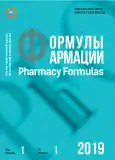Alopecia: from clinic to preclinic and back
- 作者: Ivkin D.Y.1, Nogaeva U.V.1, Flisyuk E.V.1, Pisetskaya M.V.1, Shtyrlin Y.G.2
-
隶属关系:
- Saint-Petersburg Chemical-Pharmaceutical University, St. Petersburg
- Kazan Federal University
- 期: 卷 1, 编号 1 (2019)
- 页面: 44-51
- 栏目: Pharmaceutical Sciences
- URL: https://journals.eco-vector.com/PharmForm/article/view/18524
- DOI: https://doi.org/10.17816/phf18524
- ID: 18524
如何引用文章
全文:
详细
On average, 60–70% of men and 25–40% of women suffer from various forms of hair loss on our planet. If we turn to WHO statistics, we can see that about 75% of Russians are more or less susceptible to baldness. The hair follicle is an appendage of the skin, a kind of mini-organ that cyclically changes throughout a person’s life. Periods of regeneration and rapid growth (anagen) alternate with periods of involution (catagen) and dormancy (telogen). As a rule, hair begins to fall out when the correlation between the number of hair follicles in different phases of development is violated. The occurrence of alopecia is associated with the influence of heterogeneous etiological factors, which further determine the pathogenesis of the disease and the clinical picture. The treatment of alopecia requires the use of a personalized approach to each patient. Both medicinal and cosmetic compositions are available for therapy in different dosage forms. At the same time, there remains a need for the search for new active pharmaceutical substances and the development of drugs based on them. However, in order to develop effective therapies, we need to reconstruct in detail the pathogenesis of alopecia on animal models. Then the extrapolation of the result human-animal-human will be accurate and problem-free, and the search for new means — successful.
作者简介
Dmitry Ivkin
Saint-Petersburg Chemical-Pharmaceutical University, St. Petersburg
Email: dmitry.ivkin@pharminnotech.com
SPIN 代码: 9981-9772
Scopus 作者 ID: 639008
PhD of Biological Sciences, Associate Professor of the Depart-ment of Pharmacology and Clinical Pharmacology
俄罗斯联邦, 197376, St. Petersburg, Professora Popova st., 14Uliana Nogaeva
Saint-Petersburg Chemical-Pharmaceutical University, St. Petersburg
编辑信件的主要联系方式.
Email: nogaeva.u@yandex.ru
5-year student of the Faculty of Pharmacy
俄罗斯联邦, 197376, St. Petersburg, Professora Popova st., 14Elena Flisyuk
Saint-Petersburg Chemical-Pharmaceutical University, St. Petersburg
Email: elena.flisyuk@pharminnotech.com
SPIN 代码: 2585-2359
Scopus 作者 ID: 736750
Doctor of Pharmaceutical Sciences, Professor, Head of the De-partment of Technology for Dosage Forms, Vice Rector for Research
俄罗斯联邦, 197376, St. Petersburg, Professora Popova st., 14Marina Pisetskaya
Saint-Petersburg Chemical-Pharmaceutical University, St. Petersburg
Email: marina.piseckaya@pharminnotech.com
1 year postgraduate student of the department of technology of dosage forms
俄罗斯联邦, 197376, St. Petersburg, Professora Popova st., 14Yuri Shtyrlin
Kazan Federal University
Email: Yurii.Shtyrlin@kpfu.ru
SPIN 代码: 9316-4418
Scopus 作者 ID: 53267
Director of the Scientific and Educational Center for Pharmaceuticals
俄罗斯联邦, 18, Kremliovskaya street, Kazan, 420008参考
- URL: http://www.medcenterrosh.ru/trikhologiya/alopeciya.html (дата обращения: 14.09.2019)
- URL: http://optimahair.ru/articles/androgeneticheskaya-alopetsiya/ (дата обращения: 03.10.2019)
- URL: http://estportal.com/pigment-volosa/ (дата обращения: 05.10.2019)
- Корнишева В.Г., Ежов Г.А. Патология волос и кожи волосистой части головы. – СПб: ООО «Издательство Фолиант», 2012. – 200 с.
- Малова И.Ю., Рубайлов Ю.В. Волосы: анатомия, физиология, патофизиология // Методическое пособие. – Майкоп. 2015.
- Самцов А.В., Божченко А.А. Патогенез андрогенетической алопеции: современное состояние проблемы // Русский медицинский журнал. – 2006. – Т. 14. – №15 (267) – С. 1141–1144.
- Залкинд Е.С. Болезни волос/ Медгиз. Ленинградское отделение, 1959. – 179 с.
- Нажмутдинова Д.К. Алопеция: диагностика и лечение//Медицинский совет. – 2010. – №5.– С. 87–91.
- Messenger A.G., de Berker D.A.R., Sinclair R.D. Chapter 66. Disorders of Hair. In: Rook’s Textbook of Dermatology. 8th ed. Oxford, UK: Blackwell Science Publications; 2010. p. 66.1–66.16. https://doi.org/10.1002/9781444317633.ch66
- Messenger A.G., Sinclair R. Follicular miniaturization in female pattern hair loss: clinicopathological correlations. Br J Dermatol. 2006 Nov; 155(5): 926-30.
- Мяделец О.Д., Адаскевич В.П. Морфофункциональная дерматология. – М: Медлит, 2006. – 752 с.
- Адаскевич В.П., Мяделец О.Д., Тихоновская И.В. Алопеция. М.: Мед.книга. 2000;187.
- Бакиева А.Р., Исентаев А.А., Севастьянова Е.А. ПАТОФИЗИОЛОГИЯ АЛОПЕЦИИ // Международный студенческий научный вестник. – 2019. – № 3.; URL: http://www.eduherald.ru/ru/article/view?id=19656 (дата обращения: 13.10.2019).
- Овчаренко Ю.С. Актуальные проблемы трихологии на современном этапе // Дерматовенерология. Косметология. Сексопатология. – 2007. – №4. С. 262–265
- М.В. Воронкова, О.Л. Иванов, И.В. Кошелева и др. Современные подходы к лечению рубцовых алопеций. // Российский журнал кожных и венерических болезней. – 2012. – №5. – С. 26–29.
- URL: https://helpiks.org/3-85009.html (дата обращения: 08.10.2018)
- Т. Т. Беречикидзе, К. М. Ломоносов Вирусная гипотеза патогенеза гнездной алопеции (теория патогенеза). // Российский журнал кожных и венерических болезней. – 2012. – №2. – С. 56–58.
- Сенчукова С.Р., Кузнецова А.В., Криницына Ю.М. Современные методы мониторинга и дифференциальной диагностики нерубцовых форм алопеций // Современные проблемы науки и образования. – 2017. – № 1.
- URL: http://www.science-education.ru/ru/article/view?id=25905 (дата обращения: 13.10.2019).
- С.Б. Ткаченко, О.Ю. Олисова, Е. Ю. Пащенко и др. Терапия диффузной алопеции с использованием внутрикожного введения витаминов группы В и комплекса Цистин В6. // Российский журнал кожных и венерических болезней. – 2013. – №3. – С. 58–61.
- URL: http://www.netvolos.ru/rus/articles/androgen-alopecia.htm (дата обращения: 12.09.2019)
- Самцов А.В., Божченко А.А. Патогенез андрогенетической алопеции: современное состояние проблемы//Русский медицинский журнал. – 2006.– Т. 14, №15 (267). – С. 1141-1144.
- – Карнаухов В.К. Современные подходы к лечению андрогенетической алопеции// Вестник дерматологии и венерологии. – 2017. – №1. – С. 21—30
- Новый взгляд на патогенез и лечение андрогенетической алопеции/Е.Карасев, Т.Винник. URL: http://hbp-group.ru/novyi-vzglyad-na-patogenez-i-lechenie-androgeneticheskoi-alo/ (дата обращения: 02.10.2019)
- Kanti V., Messenger A., Dobos G. et al. Evidence-based (S3) guideline for the treatment of androgenetic alopecia in women and in men – short version // J. Eur. Acad. Dermatol. Venereol. 2018. Vol. 32. № 1. P. 11–22
- Олисова О.Ю. Миноксидил в практике врача трихолога//Медицинский совет. – 2018. –№6. – С. 145–147. doi: 10.21518/2079-701X-2018-6-145-147
- URL: https://www.pharmacosmetica.ru/(дата обращения: 12.10.2019)
- Б.Н. Гамаюнов, Оценка эффективности парентерального введения высоких доз метилпреднизолона в период манифестации и прогрессирования гнездной алопеции на экспериментальной модели мышей линии HRS./Н.Г. Короткий, М.А. Стенина, Л.И. Кривов//Современные технологии в диагностике и лечении. – 2011. – №1. – С. 37-40.
补充文件







